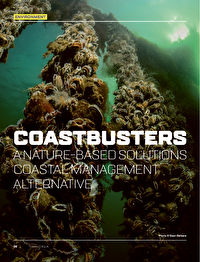Today’s challenges of erosion, flooding and storm surges are primary concerns for coastal communities around the world. Traditional coastal engineering solutions, such as concrete seawalls or rock breakwaters however, will become unsustainable due to their limited resilience, higher costs, societal impacts and unwanted ecological side effects. In response to these challenges, Coastbusters developed a nature-based solutions approach to sustainable coastal management. These solutions will create new habitats based on known ‘biobuilder species’ in the form of biogenic coastal reefs. The purpose of the reefs is to induce natural accretion of sand, attenuate storm waves and reinforce the foreshore against coastal erosion, thus adding to coastal protection.
Coastal zones are under duress of climate change (e.g. sea level rise, intensification of storms, increasing beach erosion) and enhanced anthropogenic pressure (e.g. demographic evolution, loss of habitats, economic expansion). Both hard and soft conventional coastal protection measures, such as sea walls, dykes, embankments and beach reclamations, are increasingly required to combat flood risks (Malherbe et al., 2013).
Conventional coastal protection measures however, are currently challenged by stakeholders because they are seen as unsustainable and carry high installation and structural maintenance costs. Hard structures are designed for current sea levels and are incapable of adapting to increasing flood risks. Soft measures will suffer from storm events and require additional maintenance afterwards. As a consequence, current civil engineering approaches can fall short in efficiently and cost effectively protecting the coast (Syvitski et al. 2009). This often results in negative or unforeseen impacts on local ecology and surrounding ecosystems on larger scales, reducing the resilience of the coast.
Resilient coastal protection
Innovative, sustainable and perennial approaches for a resilient coastal protection are therefore crucial to safeguard economic, environmental and societal assets of the coast. In recent decades, sustainable coastal management approaches have emerged within the nature-based solutions (NBS) philosophy (European Commission, 2015; IUCN, 2016; Nesshöver et al., 2017). In this context, the application of ecosystem engineering species for achieving civil engineering objectives is not new. From a coastal protection point of view, these species need to have the ability to modify the local physical environment by their structures or activities to trap sediments and attenuate waves (Borsje et al., 2011; Emmerman et al., 2013). Examples of coastal ecosystem engineers are numerous, with the most tangible being dune vegetation, seagrasses, corals and mangroves.
An ecosystem-based coastal flood protection can only be brought into largescale practice as a regional solution, on condition that:
- sufficient space is present to accommodate the creation and development of (additional) ecosystems;
- key engineering species and its habitat naturally occur; and
- local stakeholders support development of ecosystem services.
Once these conditions are met, solutions can be designed to translate the desired ecosystem engineering functionality into coastal management measures. On the one hand, such development requires a generic framework to select the appropriate measures based on the spatial and temporal scale of coastal protection. On the other, it requires knowledge (and broad dissemination thereof) on the ecology, engineering and ecosystem services delivered by the reef-forming ecosystem.
The core of Coastbusters is to understand and validate the underlying processes that drives this natural biostabilisation. To translate the optimal conditions for the development of biogenic reefs into an engineered design will generate a new business model for coastal management (Sterckx et al., 2019). To unravel this dynamic interaction between traditional technical and ecological engineering requires diverse expertise and multidisciplinary collaboration. Therefore, an exceptional public-private partnership was created. The Coastbusters consortium is currently composed of three companies, Dredging International (part of the DEME group), Jan de Nul and Sioen industries, together with two research institutes, the Institute for Agricultural, Fisheries and Food Research (ILVO) and the Flanders Marine Institute (VLIZ). The Coastbusters research projects are facilitated by the Blue Cluster (DBC) and supported by the Flemish agency for Innovation and Entrepreneurship (VLAIO).


































